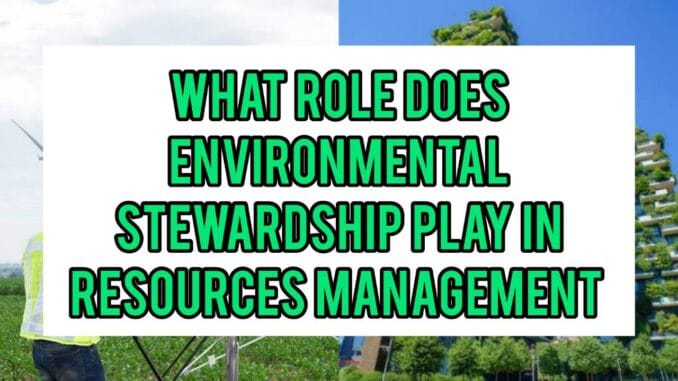
Have you ever thought of why some forests stay lush and rivers keep flowing, while others dwindle into parched land? That magic isn’t magic at all—it’s environmental stewardship in action. Environmental stewardship is like being a careful gardener for our planet, tending to soils, waters, and ecosystems so they continue supplying the resources we all depend on. In this article, we’ll explore everything about how stewardship underpins smart resource management, why it matters, and how each of us can play a part.
Defining Environmental Stewardship
At its simplest, environmental stewardship means caring for the Earth’s natural systems. It’s a philosophy and set of actions that ensure resources—water, soil, forests, minerals—are used responsibly, protected from harm, and passed on in healthy condition to future generations. Think of it as a long-term lease on the planet, where you handle everything with respect, avoiding waste or damage.
The Connection Between Stewardship and Resource Management
Resource management is about deciding how to extract, use, and protect natural assets. Stewardship adds the guiding principle of care: not just how much we take, but how we maintain balance. It shifts the mindset from “take what we can” to “take only what we need, and give back.” Without stewardship, resource management risks short-term gains at the expense of long-term collapse.
Core Principles of Environmental Stewardship
Environmental stewardship rests on three pillars: sustainability, conservation, and collaboration. Sustainability ensures resources regenerate faster than they’re consumed. Conservation focuses on protecting vulnerable species and habitats. Collaboration brings governments, businesses, communities, and individuals together. These principles weave into every decision, from farming to fishing, forestry to fisheries.
Historical Roots of Stewardship
Long before modern environmental science, indigenous peoples practiced stewardship by living in harmony with nature. They rotated crops, maintained sacred groves, and honored water spirits. Fast forward to the 20th century: rising pollution and resource depletion sparked conservation movements, national parks, and global treaties. Today, stewardship blends ancient wisdom with cutting-edge science.
Why Stewardship Matters for Water Resources
Protecting Watersheds
Rivers and aquifers don’t exist in isolation—they rely on healthy forests, wetlands, and soils. Stewardship practices like reforestation, buffer strips along streams, and sustainable agriculture prevent erosion and sedimentation, keeping water clear and plentiful.
Ensuring Clean Drinking Water
Polluted water sources force expensive treatment or create health crises. Stewardship means limiting chemical runoff from farms, treating wastewater properly, and monitoring industrial discharges. In effect, it’s like putting a filter on the entire landscape, safeguarding every drop.
Stewardship in Forest Resource Management
Selective Logging and Replanting
Instead of clear-cutting entire stands, foresters practice selective logging—harvesting only mature trees and leaving young ones to grow. Planting native species afterward ensures the forest canopy stays intact. It’s similar to harvesting fruit from an orchard while keeping the trees healthy year after year.
Fire Management and Controlled Burns
In many ecosystems, occasional fires help clear underbrush and trigger seed germination. Stewardship includes planned burns under safe conditions, reducing the risk of uncontrolled wildfires while maintaining ecological balance.
Agricultural Stewardship for Soil Health
Crop Rotation and Cover Crops
Growing the same crop repeatedly drains soil nutrients. Rotating with legumes or using cover crops like clover restores fertility and prevents erosion. It’s like giving the soil a balanced diet rather than feeding it junk food.
Organic and Regenerative Practices
Reducing synthetic fertilizers and pesticides protects soil microbes and beneficial insects. No-till farming preserves soil structure and carbon content, combating climate change. Stewardship in agriculture means nurturing the earth so it can nourish us in return.
Fisheries Management and Marine Stewardship
Catch Limits and Quotas
Overfishing can collapse entire fish populations. Stewardship sets science-based quotas, allowing species to replenish. Imagine pulling apples from a tree: you wouldn’t strip every branch bare if you wanted apples next season.
Marine Protected Areas
Designating zones where fishing and drilling are restricted gives marine life safe havens to breed and grow. These underwater reserves function like nurseries, replenishing fish stocks in surrounding waters.
Mineral Resource Stewardship
Responsible Mining and Reclamation
Mining can scar landscapes and pollute waterways. Stewardship requires companies to minimize waste, use water efficiently, and restore land after operations end—replanting native vegetation and reshaping terrain so ecosystems can return.
Circular Economy and Recycling
Rather than digging new minerals, we can recycle metals from old electronics and vehicles. Stewardship promotes material reuse, reducing energy use and ecological footprint.
Urban Stewardship in City Planning
Green Infrastructure
Urban areas can adopt stewardship through green roofs, rain gardens, and permeable pavements, managing stormwater and cooling cities. These features act like sponges and shades in a concrete environment, mimicking natural systems.
Community Gardens and Urban Forestry
Planting trees and gardens in neighborhoods cleans air, provides food, and fosters social ties. Urban stewardship brings nature into our daily lives, balancing concrete with green.
Stewardship and Climate Change Mitigation
Carbon Sequestration in Ecosystems
Healthy forests, grasslands, and wetlands capture carbon dioxide from the atmosphere. Stewardship ensures these “carbon sinks” stay vibrant, helping slow global warming—like keeping a sponge soaked to mop up excess water.
Renewable Energy and Stewardship
Transitioning to solar, wind, and hydroelectric power reduces reliance on fossil fuels. Stewardship guides siting and design to protect wildlife, land, and communities.
Economic Benefits of Environmental Stewardship
Sustainable Jobs and Industries
Stewardship spurs green jobs in renewable energy, ecological restoration, and sustainable agriculture. These sectors often provide stable, long-term employment.
Avoiding the High Cost of Degradation
Neglecting stewardship leads to resource scarcity, pollution, and health crises—costing economies billions in cleanup, healthcare, and lost productivity. Investing in stewardship is like buying an insurance policy against future disasters.
Social and Cultural Dimensions of Stewardship
Community Engagement and Education
Effective stewardship depends on local knowledge and buy-in. Community workshops, school programs, and citizen science projects invite residents to become caretakers of their environment.
Cultural Values and Traditional Practices
Many cultures hold deep respect for nature, celebrating rituals that honor the land and water. Stewardship recognizes and integrates these traditions, blending them with modern management.
Policy and Governance in Stewardship
Regulation and Incentives
Governments set the rules for resource use, pollution limits, and land protection. Stewardship flourishes when policies align with sustainable goals, offering tax breaks or subsidies for eco-friendly practices.
International Cooperation
Shared resources like rivers, oceans, and migratory species cross borders. Stewardship requires treaties and agreements—like the Paris Climate Accord—to coordinate global action.
Technological Tools for Stewardship
Remote Sensing and GIS Mapping
Satellites and drones monitor forests, waters, and land use in near real-time, helping managers detect illegal logging, track wildlife migrations, or assess drought impacts.
Data-Driven Decision Making
Big data analytics and AI model resource scenarios—predicting fish stock health or water availability decades ahead. Stewardship uses these insights to plan wisely, avoiding overuse or unintended consequences.
Challenges in Implementing Environmental Stewardship
Balancing Short-Term Needs and Long-Term Goals
Developing nations often face pressure to exploit resources for immediate growth. Stewardship requires weaving economic development with conservation, ensuring growth doesn’t sacrifice future prosperity.
Funding and Capacity Constraints
Stewardship programs need funding for personnel, equipment, and monitoring. Securing sustained financing—through public budgets, grants, or private partnerships—is often a hurdle.
Success Stories in Stewardship
The Rebirth of the Mississippi River Basin
Collaborative stewardship across states and farmers reduced fertilizer runoff, reviving habitats and improving water quality downstream. This multi-stakeholder effort shows how shared vision and data can restore mighty rivers.
New Zealand’s Marine Reserves
Māori-led stewardship zones protect fish and seabed habitats, blending indigenous knowledge with modern science. Fish populations have rebounded, benefiting both ecosystems and local fisheries.
Measuring Stewardship Outcomes
Key Performance Indicators
Metrics like water quality indices, forest cover change, and species population trends track progress. Regular reporting and transparency build trust and guide adaptive management.
Adaptive Management
Stewardship isn’t static; managers adjust actions based on monitoring results—like a thermostat responding to temperature changes. This feedback loop ensures continuous improvement.
The Future of Environmental Stewardship
Integrating Tech and Traditional Wisdom
The synergy of drones and ancestral land-care practices offers precision and cultural relevance. Stewardship evolves by blending the old with the new.
Global Youth Movements
Young activists around the world press for stronger stewardship, from school strikes to community cleanups. Their energy fuels policy shifts and public awareness.
How You Can Be a Steward
Each of us can contribute: reduce water use, support sustainable products, volunteer for local restoration projects, or advocate for green policies. Stewardship begins at home, then ripples outward.
Conclusion
Environmental stewardship weaves respect for nature into every choice—how we farm, fish, build, and govern. It transforms resource management from a zero-sum game into a balanced partnership with Earth’s systems. By embracing stewardship principles, we ensure clean water, rich soils, and vibrant ecosystems endure, granting our children and grandchildren the same natural bounty we enjoy today.
FAQs
What’s the difference between conservation and stewardship?
Conservation focuses on setting aside land or species for protection, while stewardship encompasses ongoing care and sustainable use of natural resources.
How does stewardship affect everyday consumer choices?
By choosing products from sustainably managed forests, fisheries, and farms, consumers support stewardship practices and encourage businesses to adopt them.
Can technology replace traditional stewardship practices?
Technology enhances monitoring and efficiency but works best when combined with traditional ecological knowledge and community engagement.
How do governments enforce stewardship policies?
Through regulations, permits, and penalties for non-compliance, coupled with incentives for sustainable practices like tax breaks or subsidies.
What role do individuals play in global stewardship efforts?
Individual actions—reducing waste, conserving water, volunteering—collectively influence markets, policies, and corporate behavior, amplifying stewardship worldwide.

Paul is a seasoned ecologist with over ten years of professional experience in managing environmental resources and exploring the emerging field of space ecology. Throughout his career, he has contributed to sustainable ecosystem research and examined how ecological principles apply beyond Earth, particularly in space missions and extraterrestrial environments. His work bridges the gap between Earth-based conservation efforts and the future of human life in space, making him a valuable expert in both traditional and cutting-edge ecological studies.
Leave a Reply